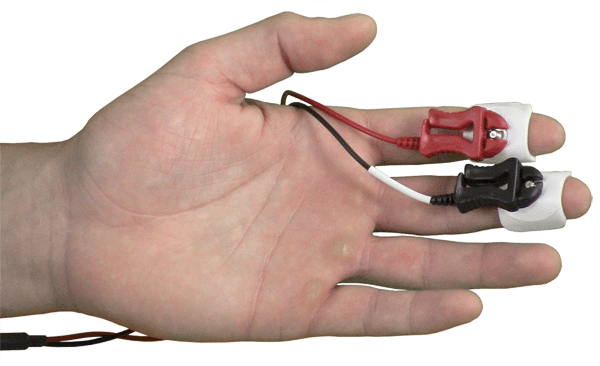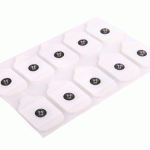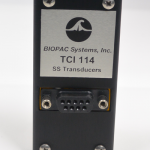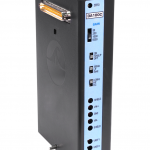The EDA/GSR leads snap to two disposable Ag-AgCl electrodes (EL507 or equivalent) that are attached to the Subject. The electrode leads are shielded to minimize noise interference and improve recordings.
BSL Lessons automatically detect and optimize setup.
For Skin Resistance measurements: Set an Expression calculation channel to take the reciprocal of conductance, and then apply proper scaling.
BSL PRO and AcqKnowledge software include the following EDA/GSR presets for user-defined recordings:
Electrodermal Activity (EDA/GSR), 0-35 Hz; requires calibration—see specifications or hardware guide for details.
Electrodermal Activity (EDA/GSR) Change; no calibration required (BSL PRO 4.0.3 and earlier only)
The SS57LA/57L operates by applying a fixed 0.5 Volts DC across the two electrodes and then measures the current flowing between the two electrodes. Because the voltage (V) is fixed, from Ohms Law, the conductance (G) will be proportional to the current (I): G = I/V = I/0.5 V. Circuitry in the SS57L then converts the detected current to a voltage so it can be measured by the MP device. The software performs the necessary scaling and units conversion.
TIP To detect a good signal, subjects should have a little sweat on their hands (not a lot, but enough so that their hands are not completely smooth or cold). If subjects wash their hands just prior to the recording or if they have been sitting in a cold room, then they must do something to activate the sweat glands before beginning calibration or recording. If subjects begin with colder hands, the scale will be diminished and the signal will be easily saturated once they “warm up” during the lesson.
EDA “Electrodermal Activity” is also known as GSR “Galvanic Skin Response.” Use BIOPAC Electrodermal Activety (EDA) hardware to record Galvanic Skin Response (GSR) Data.





Stay Connected